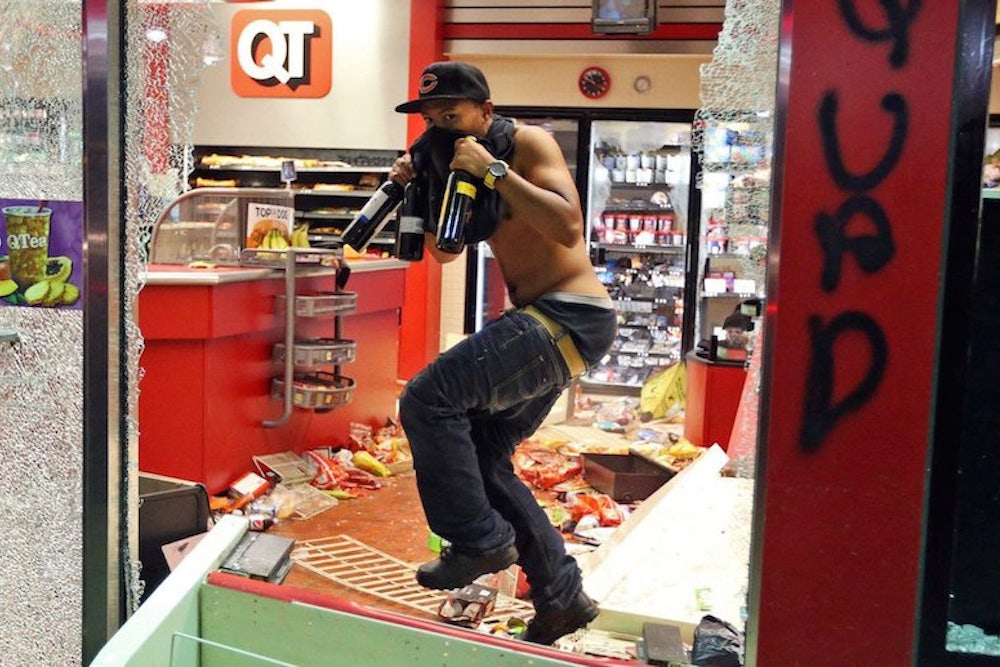Who loots a QuikTrip? The Midwestern convenience store sells candy bars, chips and oversized sodas—hardly anything worth stealing. Yet Monday night, a QuikTrip in suburban St. Louis became the focal point for violent protests after a white police officer shot and killed Michael Brown, an unarmed black 18-year-old, on Saturday. Looters smashed the store’s windows, flipped over shelves inside, stuffed their pockets with junk food and then burned the store to the ground. They left graffiti on the burned shell of a building that called for the murder of police officers.
To understand why QuikTrip was looted, it is first important to understand that St. Louis is a commuter city. Its suburbs are a patchwork of small townships, connected by highways that slow to a crawl during rush hour. It is joked that for a St. Louisan to get his mail from the mailbox, he must first hop on Highway 44 for a few minutes to get there. QuikTrip is a chain of mega-gas stations with over a dozen gas pumps located on its sprawling concrete parking lot, with a giant convenience store at each location. On any given morning, a QuikTrip is crowded with groggy commuters buying coffee, construction workers buying breakfast burritos and teenagers loitering on the sidewalk out front before school. In this way, each QuikTrip is a kind of micro town square, a public meeting place of commerce and community. And this is what the looters seemed intent on smashing and burning: The town square, and the very economic order of St. Louis.
The social and economic reality of St. Louis is pretty simple. Prosperity is white, and poverty is black. It has been this way for decades, and the contours of this reality has become self-reinforcing. White residents have built their own affluent enclaves farther and farther from the city’s core, in suburbs like Chesterfield, some 30 miles from downtown, where brand-new, dueling outlet malls have opened for business. Black residents live in a belt of communities along the northern side of the city in townships like Ferguson, or Baden that were abandoned by white residents, where the quaint strip malls of yesteryear are largely abandoned and storefront windows are covered with plywood.
The black community in urban and inner-suburban St. Louis has suffered within the confines of this system. Missouri had the nation’s highest black homicide rate in 2010 and the second-highest in 2011, according to Violence Policy Center. When a black teenager is murdered, it can rate no more than a 300 word story in the local newspaper. The city’s school system is largely composed of dysfunctional barracks where kids are kept for the day. In 2011, The high school graduation rate for St. Louis city was about 50 percent (in the largely white and affluent suburb of Clayton, by contrast, it is 98.5 percent), according to a tally in the St. Louis Post Dispatch.
Cops throughout St. Louis and its suburbs have the unenviable task of policing this social order. Lower-middle-class police officers patrol the gutted city neighborhoods that other white St. Louis residents avoid. The officers get shot at, yelled at, and in return they use unnecessary violence to make their presence felt. The cycle of mistrust, resentment and hostility between police and the black residents of St. Louis has been building for decades, and now it is boiling over. When a police officer gunned down Brown, black witnesses nearby described the scene as murder—a young man with his arms up, compliant, shot in the face and chest. It was the catalyst to rise up against the tectonic inequalities of St. Louis.
Burning a QuikTrip is an easy way to express rage at the city, at its history, at the police, and the social order. The morning after the looting, a man who identified himself as DeAndre Smith stood in the QuikTrip parking lot as the building smoldered behind him.
“This is exactly what’s supposed to happen, when there’s injustice in your community,” Smith told a videographer for the St. Louis Post-Dispatch.
Gesturing to the QuikTrip, he explained why it should be destroyed.
“It’s how they receive money. Businesses. The taxes. Police stopping people, giving them tickets, taking them to court, locking them up … That’s how they make money in St. Louis. Everything is all about money in St. Louis … They’re organized. They have certain things in a certain way: Secret society type of deal. ‘We’re gonna eat, and you’re gonna starve.’”
Smith seemed elated, or at least adrenalized, at the notion that his black friends and neighbors where finally setting something on fire.
“I don’t think it's over, honestly. I just think they got a taste of what fighting back means.”
Correction: A previous version of this article misspelled QuikTrip.
